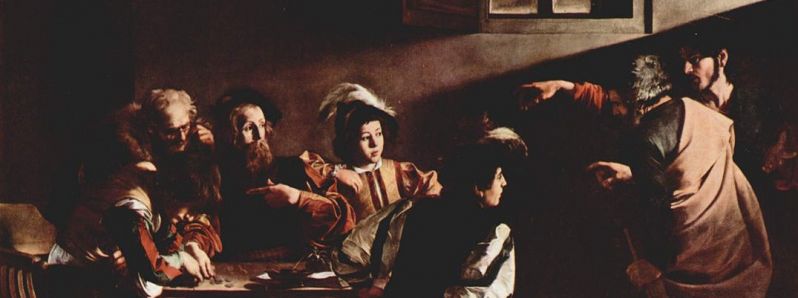
When in Rome… I’m pretty sure you saw pictures of long lines of people waiting to get access to the famous attractions of Rome like the Colosseum or the Vatican Museums, and for these I really recommend you take one of our tours so you can skip the lines and have a qualified guide leading you through their history. The truth is that Rome is an open-air museum, you can take a journey through the eternal city just walking along the tiny streets of the city center: huge squares, monuments, glorious fountains and churches will fulfill your eyes with wonder.
There is so much to see, but today I’d like to tell you which are the places where you can find the masterpieces painted by the famous Caravaggio (Michelangelo Merisi from Caravaggio).
Let’s start by saying that fewer than 80 Caravaggio’s are recognized in the whole world among churches, museums and private collections (the authenticity of some of which is still a matter of debate among historians) so, when a new Caravaggio is discovered it’s easy to hear about people ready to pay staggering figure to have it. In 2014, for instance, a painting was discovered in Toulouse (France) and then sold for more than €100 million! – experts are divided over whether the work is truly by Caravaggio!
What has made Caravaggio one of the most important artists of all time is the revolution that he brought into the art world. As revolutionary at the time as Picasso was in the 20th Century, he combined a dramatic use of light and shadows – chiaroscuro – with a realistic physical observation, working with live models taken from the streets of Rome. He had an incredible influence on the Baroque art; an entire generation of painters following his style were called “Caravaggisti”.
Where can you see Caravaggio for free in Rome? Let’s not beat around the bush, the answer is simple: in churches, that is their original setting! Rome holds the world record as the city with highest number of churches, over 900! They are not just religious temples but real caskets of artistic treasures. Here are the ones hosting Caravaggio’s canvas, they are within walking distance of each other in the beautiful city center of Rome:
1. Santa Maria del Popolo – Cerasi chapel

Pic by Frederick Fenyvessy – Wikicommon CC-BY-2.0
The church is located in the scenographic piazza del Popolo, a square that once welcomed people traveling to Rome from the north. Indeed, the church is next to Porta del Popolo an ancient door of the city. You can easily reach the square by subway, A-line, Flaminio stop. Get in and walk till the end of the left aisle, you will find a small chapel hosting different treasures. You will definitely be impressed by the difference between the style of the altar piece compared to the two pictures on the sides. It will be easy to recognize which are the works by Caravaggio because of his unique way to use light and shadows, but as groundbreaking and successful as his art was, it wasn’t the only artistic current of the time. This is well shown in the central Assumption of the Virgin by the classicist master Annibale Carracci.
Let’s focus now on the Caravaggio’s: The Conversion on the Way to Damascus and the Crucifixion of Saint Peter, both commissioned in September 1600 by Monsignor Tiberio Cerasi, Treasurer-General to Pope Clement VIII.
Conversion on the Way to Damascus
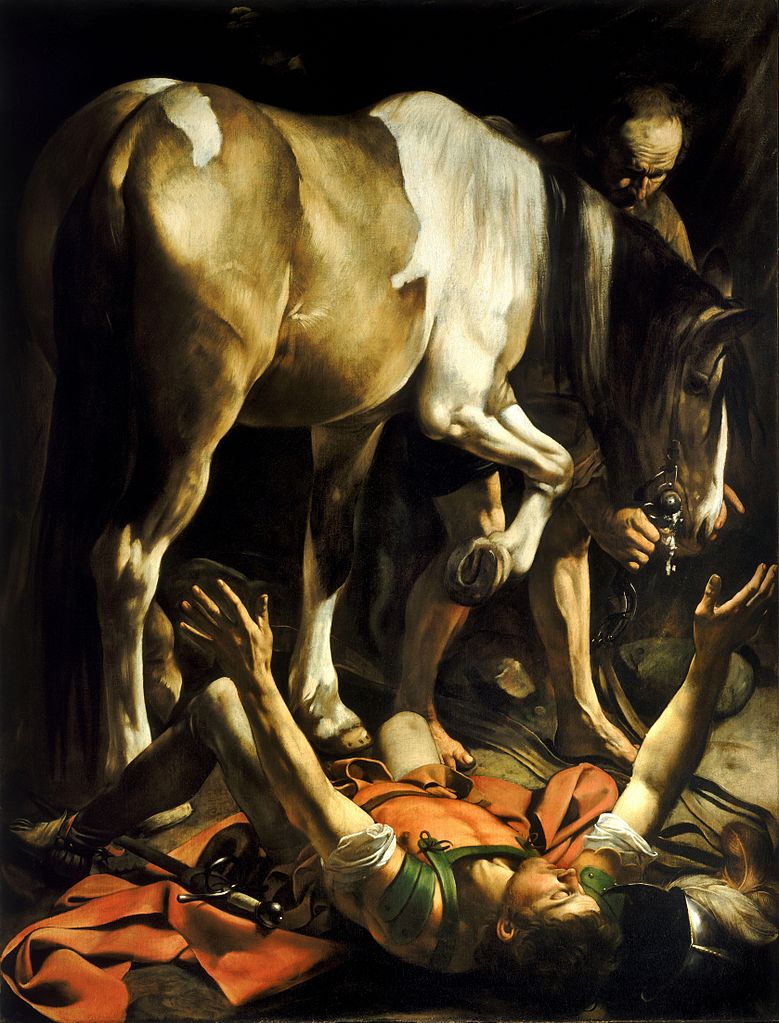
St. Paul was a Pharisee with roman citizenship and was against the new Christian religion. He had an active role in their persecution. In this masterpiece Caravaggio depicts the moment of Paul’s conversion as described in the Acts of the apostles (9): – “As he neared Damascus on his journey, suddenly a light from heaven flashed around him. He fell to the ground and heard a voice say to him,”Saul, Saul, why do you persecute me?””Who are you, Lord?” Saul asked.”I am Jesus, whom you are persecuting,” he replied. “Now get up and go into the city, and you will be told what you must do.” – Paul is represented in a moment of intense religious ecstasy. The light is here the absolute protagonist of the scene as if the characters had been in complete darkness before the epiphany of the divine light.
Crucifixion of Saint Peter
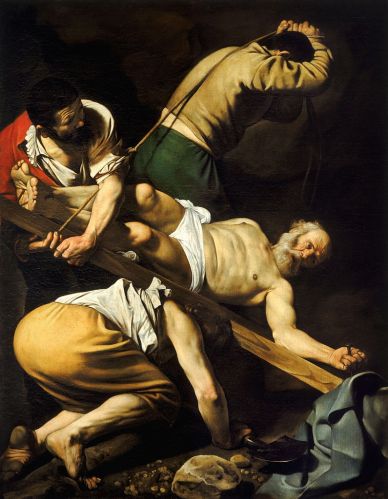
St. Peter was the leader of the apostles and considered the first pope in history, chief of the roman Christian community, who died under the persecutions of the emperor Nero between 64-68 AD. In this painting, Caravaggio shows the moment of his martyrdom: according to tradition, Peter requested to be crucified upside-down because he did not believe that a man was worthy to be killed in the same way as Jesus Christ. In the picture the executioners seem to struggle to lift the cross, their faces are almost invisible, and the light shows Peter’s aged body but still strong and muscular. In the background we can see a rocky cliff. This is an allusion to the meaning of Peter’s name: the “rock” upon which Christ declared his Church should be built.
2. Church of San Luigi dei Francesci – Contarelli chapel
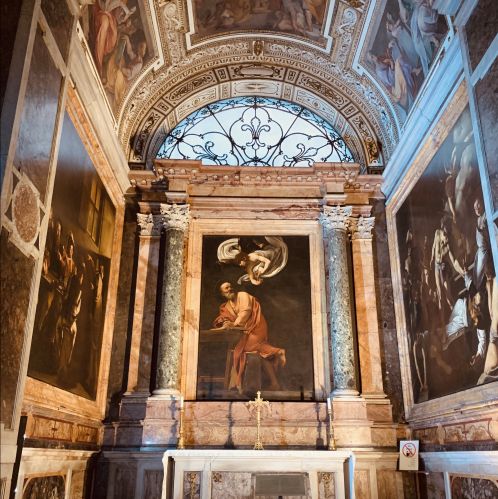
This was Caravaggio’s first major public commission, it made him the most famous painter of the time in Rome. In the Contarelli chapel we are lucky enough to see three paintings on the theme of Saint Matthew the Evangelist.
The French cardinal, Matthieu Cointerel (Contarelli in Italian), purchased the chapel in the church of the French community in Rome. He died in 1585 but left instructions for the chapel, specifying that it should be decorated with scenes from the life of his name-saint, Matthew the Evangelist.
The Calling of Saint Matthew
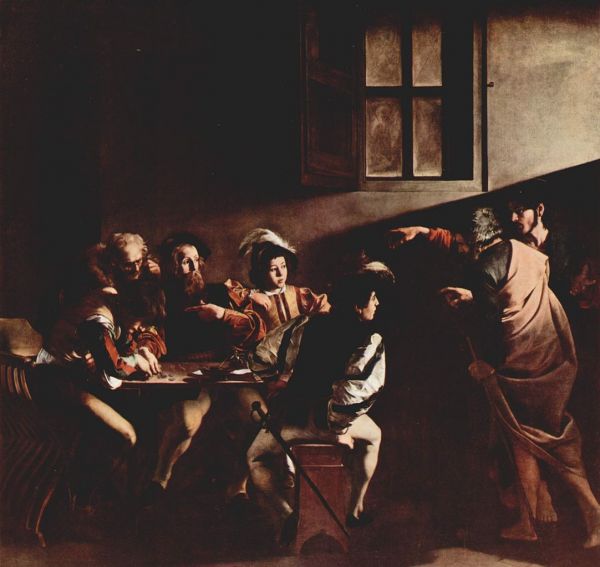
The subject of this painting is taken from the Gospel of Matthew (9:9): “Jesus saw a man named Matthew at his seat in the custom house, and said to him, “Follow me”, and Matthew rose and followed Him.” Caravaggio depicts Matthew as a bearded man, while at work (he was a tax collector), his expression is full of wonder, pointing at himself, as if to answer to Jesus’s call with the question “really me?”. The use of light is extremely symbolic, the only source is the beam of light coming from Christ’s direction: he brings true light into the dark space.
The Martyrdom of Saint Matthew
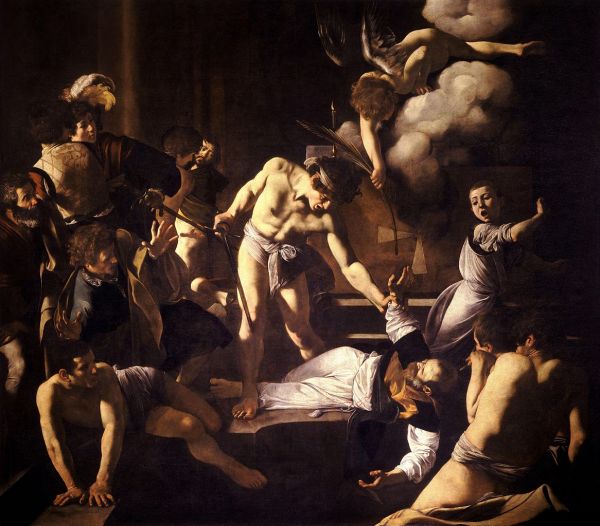
The painting hangs opposite the Calling and shows the martyrdom of the Saint. According to tradition, the king of Ethiopia was rebuked by Matthew because he wanted to marry his own niece who was a nun, so the bride of Christ. The saint was then killed while celebrating Mass by a man on the king’s orders. The scene looks confused, the characters are expressing different emotions: Matthew has no fear, he opens his arms in a pose that remarks the shape of the cross and he is ready to accept the palm of martyrdom from the angel. The light this time is not focusing the attention on the Saint but on the executioner, as he is the true protagonist and sinner, it is on him that the saving light of God must act.
The Inspiration of Saint Matthew
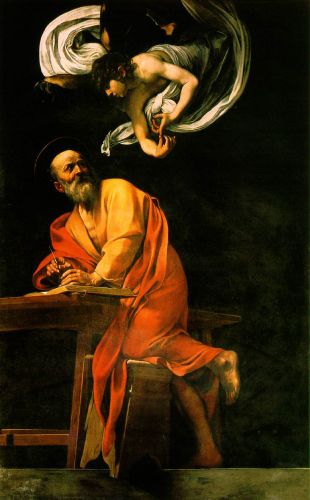
Maybe the most important canvas of the chapel, and altar piece. Caravaggio’s first version “Saint Matthew and the angel” was rejected by the patron because of what was deemed an excess of realism: the saint was represented as a bald peasant with dirty legs. This allows to make you understand how provocative and controversial the artist was in his time. Unfortunately, it was destroyed in 1945 in Berlin and is now known only from black-and-white photographs. To embrace the patron desire of an idealization of the Saint, Caravaggio created a second version that you can see here, the Inspiration. The Saint became a wise and an intellectual who, inspired by the angel, is composing his gospel.
The Contarelli Chapel was an incredible success, Caravaggio was hailed as a great artistic visionary: ‘The painters then in Rome were greatly impressed by his novelty and the younger ones especially gathered around him and praised him as the only true imitator of nature. Looking upon his works as miracles, they outdid each other in following his method’ (Bellori).
3. Church of Sant’Agostino – Cavalletti chapel
This church is well known for its renaissance architecture and because houses beautiful artwork by artists such Raphael, Bernini, Guercino and Caravaggio.
Pilgrim’s Madonna or Madonna of Loreto
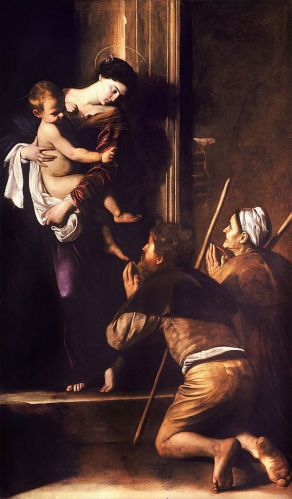
Commissioned by the heirs of the marquis Ermete Cavalletti for the family chapel, the theme should be the Madonna of Loreto as requested in the marquis will. The masterpiece depicts the Virgin Mary with the Child and two peasants on a pilgrimage at the door of the Nazareth Holy House.
From the records of that time, we know that, when the painting was unveiled, “caused the common people to make a great cackle over it” (Baglione). We can easily understand the reason of this reaction, first in the foreground there are the dirty, bare feet of the pilgrim and second the Virgin Mary could be any woman, the only thing that sanctifies her is the halo. Another scandalous element is given by the physiognomic features of the Virgin: Caravaggio used as a model a famous courtesan of the time, Lena, one of the artist’s lovers.
In less than an hour you walked through some of the most characteristic streets of Rome, discovered some of the most beautiful paintings in history, and you didn’t have to pay any ticket!
Estimated distance and time: 1.9 km, 50 minutes

Davide Bello – BA History of Art
Licensed Rome and Vatican tour guide